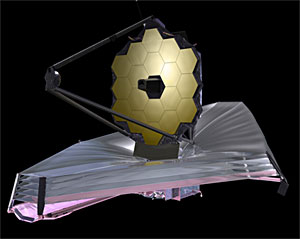By Melinda Rose, Senior Editor
WASHINGTON, Sept. 20, 2011 — Two months after a House committee recommended defunding the project altogether, the James Webb Space Telescope was saved by a Senate subcommittee, which is allocating $530 million to the international project in 2012. The 2012 appropriations bill now awaits votes of the both the full House and Senate.
The James Webb Space Telescope is a space-based observatory obtimized for infrared wavelengths, which is expected to be the successor to the Hubble Space Telescope. With its much larger primary mirror and position in deep space, the JWST is designed to look further back in time and find the first galaxies that formed in the early universe, as well as peer inside dust clouds where stars and planetary systems are forming today.

A September 2009 artist conception of the James Webb Space Telescope, with its five-layer sunshield stretched out in space. (Image: NASA)
The National Aeronautics and Space Administration (NASA) is the lead partner in the JWST, and the European and Canadian space agencies have also made significant contributions. A total of 14 countries are involved in building the space telescope.
Reconciling the funding bills in both chambers could take some doing, as the two bodies differ significantly on funding amounts for NASA and the National Science Foundation (NSF), among others.
On Sept. 14, the US Senate Appropriations Subcommittee on Commerce, Justice, Science, and related agencies released its fiscal year 2012 appropriations bill and set NASA funding at $17.9 billion, a reduction of $509 million, or 2.8 percent, from 2011 funding. Included in the bill is money to enable the infrared James Webb Space Telescope (JWST) to launch in 2018, the subcommittee said, as well as $1.2 billion for NASA's Orion Multipurpose Crew Vehicle and $1.8 billion for the heavy lift Space Launch System.
The funds the Senate provided for the telescope are significantly more than the $374 million the Obama administration requested in its 2012 budget.
In its version of the bill in July, the House Appropriations Committee recommended scrapping the JWST, citing the skyrocketing cost of the project (the $1 billion project now stands at $8.7 billion), the fact that it is years behind schedule, and "chronic and deeply rooted management problems" revealed by an independent review panel. The House's version included $1 billion for the Orion and $1.98 billion for the heavy lift launch system. The committee recommended $16.8 billion for NASA, $1.6 billion below fiscal year 2011 and $1.9 billion less than the president requested.
Under the Senate bill, NSF will receive $6.7 billion, $162 million less than this year. The House bill set the NSF budget at $6.9 billion, equal to the agency’s 2011 budget.
The Senate subcommittee also cut funding for the National Institute of Standards and Technology (NIST) to $680 million, $70 million less than the institute received this year. The bill doesn't include funding for new grants under NIST's competitive construction program and eliminates funding for the Technology Innovation Program and the Baldrige Performance Excellence Program.
For more information, visit: the JWST website, the Senate Appropriations Committee site or http://appropriations.house.gov